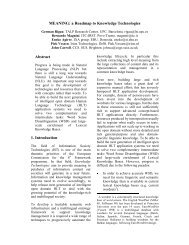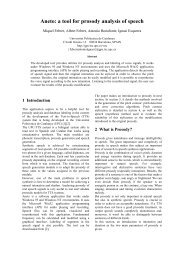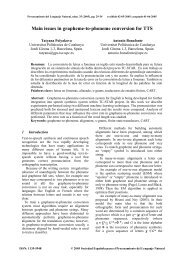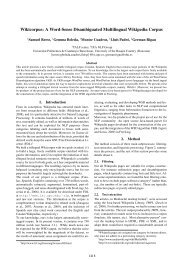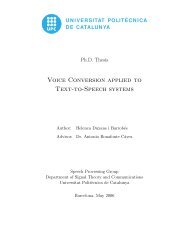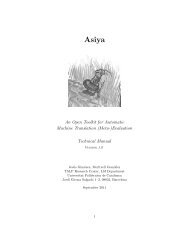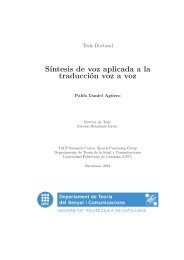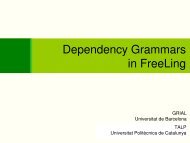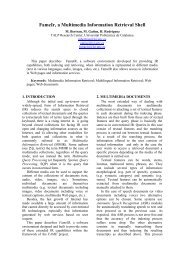Microsoft Office Outlook - Memorando - UPC
Microsoft Office Outlook - Memorando - UPC
Microsoft Office Outlook - Memorando - UPC
Create successful ePaper yourself
Turn your PDF publications into a flip-book with our unique Google optimized e-Paper software.
Javier Hernando<br />
De:<br />
Mireia Farrús [mfarrus@gps.tsc.upc.edu]<br />
Enviado el: martes, 11 de abril de 2006 15:22<br />
Para:<br />
kirk.sullivan@ling.umu.se; erik.eriksson@ling.umu.se; javier@gps.tsc.upc.edu<br />
Asunto:<br />
[Fwd: IAFL Barcelona 2006. Abstract Accepted as a POSTER]<br />
Datos adjuntos:<br />
untitled-2.htm<br />
untitled-2.htm<br />
---------------------------- Original Message ----------------------------<br />
Subject: IAFL Barcelona 2006. Abstract Accepted as a POSTER<br />
From: "M. Teresa Turell" <br />
Date: Mon, April 10, 2006 9:38 pm<br />
To: mfarrus@gps.tsc.upc.edu<br />
--------------------------------------------------------------------------<br />
Dear Ms. Mireia Farrús:<br />
I am writing on behalf of the IAFL Scientific Committee. I am delighted to inform you<br />
that your abstract "Dialect imitations in speaker recognition"<br />
has been accepted for presentation as a POSTER at the forthcoming 2nd European IAFL<br />
Conference on ForensicLinguistics / Language and the Law, to be held from 14-16<br />
September 2006 in Barcelona.<br />
The next stage will be for you to register for the conference.<br />
Registration forms, accommodation details and travel advice will be available from<br />
next week on the conference website at<br />
http://www.iula.upf.edu/agenda/iafl_bcn_06<br />
I'd be grateful if you would please try to register by the beginning of June if<br />
possible to help me with the planning of the programme. For those wishing to make<br />
travel arrangements, please note that the conference will run from early morning on<br />
14th September to late afternoon on September 16th.<br />
If you have any queries about the academic side of the conference, please contact M.<br />
Teresa Turell at teresa.turell@upf.edu. Any enquiries relating to registration should<br />
be directed to Marta Sánchez at iulaforensic@upf.edu.<br />
I will be in touch as the weeks go by with further information as appropriate, and<br />
please check the website regularly for updates.<br />
With good wishes. I look forward to seeing you in September in Barcelona!<br />
M. Teresa Turell<br />
On behalf of the Scientific Committee<br />
Evaluator A: acceptable as a poster<br />
Evaluator B: acceptable as a poster<br />
1
Dialect Imitations in Speaker Recognition<br />
Mireia Farrús 1 , Erik Eriksson 2 , Kirk P. H. Sullivan 2 and Javier Hernando 1<br />
1 Universitat Politècnica de Catalunya, Catalonia<br />
2 Umeå University, Sweden<br />
Abstract<br />
Voice imitation and disguise are possible threats to the performance of a speaker<br />
recognition system and to the accuracy of earwitness descriptions. One common<br />
disguise is the modification of the own dialect or accent. In this paper, this kind of<br />
disguising is explored, using recordings from a well-known actor with considerable<br />
experience of dialect and accent imitation.<br />
In order to see how successful his dialect imitations are and how the process of<br />
speaker discrimination is influenced by accent disguise, two sets human perception tests<br />
were constructed. One set focused on American and British English dialects, and one set<br />
on American and London English accents and Spanish-accented English. Each set<br />
consisted of three parts: a same-different speaker test, a same-different accent test, and a<br />
select the accent from a closed-set of options test. The results show that Johnny Depp is<br />
successful without his visual props and demonstrate a high correlation between the<br />
quality of the accent imitations and the failure of the human listeners to recognize that<br />
the voices come from the same speaker. The third parts of the experimental sets suggest<br />
the importance of familiarity with the accent that feeds into parts one and two. Spanish<br />
listeners, for example, are less accepting of the Spanish-accented English than non-<br />
Spanish speakers.<br />
Finally, the same speech segments used in the perception test were used in an<br />
automatic speaker recognition experiment in order to compare the results and to check<br />
the robustness of the system in front of the voice changes. The results showed, once<br />
again, a low correlation between human and automatic speaker recognition.<br />
Introduction<br />
Dialect and accent with their specific phonetic feature sets are part of the high-level<br />
voice characteristics that can provide relevant information about a person’s identity.<br />
Their importance to forensic linguistics has been pointed out by researchers such as<br />
Shuy (1995). Both dialect and accent are subject to imitation or alteration in order to
avoid or complicate the speaker’s identification. Such changes to the voice could thus<br />
affect the outcome of criminal investigations. A detailed understanding of dialect and<br />
accent traits, and how they can be disguised is, therefore, essential to the pursuit of<br />
justice in criminal law.<br />
This paper takes a two-pronged approach in its interrogation of dialect disguise<br />
and considers automatic speaker recognition and human speech perception. Such twopronged<br />
approaches were used in the speaker (cf. dialect) imitation research conducted<br />
by Sullivan and Pelecanos (2001) and Zetterholm, Blomberg and Elenius (2004). The<br />
work by Sullivan and Pelecanos showed that the recognition system was capable of<br />
classifying the mimic attacks more appropriately than human listeners. The work by<br />
Zetterholm et al. found a minimal correlation between the speaker verification system<br />
they used and their human listeners in how they judged the 62 imitations in closeness to<br />
the target speaker.<br />
The first-prong of the investigation presented in this paper, the human perception<br />
element, considers whether theatrical accent modification affects human perception in<br />
the process of voice discrimination. Stage dialects are a widely investigated<br />
phenomenon (e.g., Halloran 2003 and Machlin 1975) and are used in the theatre and<br />
film. These dialect imitations are not made to fool people, but rather to draw people into<br />
an imaginary world. A dialect imitation could however be used in a criminal setting and<br />
for this reason it is relevant to investigate how convincing dialects imitated for theatrical<br />
use are.<br />
The second-prong investigates whether speaker recognition systems are<br />
vulnerable to dialect and accent disguise. Since dialectal imitations and disguises are<br />
based mainly on high-level features such as intonation and lexical characteristics, it is<br />
not expected a priori to find a low-level based automatic recognition system capable of<br />
classifying one speaker’s talk according to the accent spoken. However, frequency<br />
characteristics can be affected by modification in intonation and acting. Stage dialect<br />
imitations provide a good way to interrogate possible vulnerabilities due to dialect and<br />
accent disguise in speaker recognition systems.<br />
Method: Human Perception Experiment 1<br />
Participants<br />
Thirty-six males and twelve females aged between 14 and 54 years who were native
speakers of English or judged themselves to be advanced learners took part in the<br />
experiment. None of the participants reported a hearing problem. The participants were<br />
recruited by the experimental leaders and requests to friends to spread information about<br />
the experiment.<br />
Material<br />
From the following movies and extra material available on DVD, five three–foursecond<br />
segments were selected: Speaker A: Chocolat (Irish), Blow (American), Finding<br />
Neverland (Scottish), From Hell (British English), Secret Window (American), and<br />
Speaker A’s own voice (extra material), and Speaker B, another male American actor<br />
speaking General American.<br />
Procedure<br />
The participants undertook three tests in a web-browser environment. Before Test 1,<br />
demographic, hearing, and language competence data was collected. In Test 1 each<br />
participant was presented with 15 randomly constructed pairs of stimuli selected from<br />
the 25 available stimuli. They were given the instructions “You are going to hear a set<br />
of files. Each file contains TWO passages. Your task is to decide if they are passages<br />
spoken by the same speaker. Indicate your decision by selecting the circle Yes or No”.<br />
In Test 2 each participant was presented with 15 randomly constructed pairs of stimuli<br />
selected from the 25 available stimuli. They were given the instructions “You are going<br />
to hear a set of files. Each file contains TWO passages. Your task is to decide if the<br />
passages are spoken by speakers of the same dialect/accent/regional variety or not.<br />
Indicate your decision by selecting the circle Yes or No”. In Test 3 each participant was<br />
presented with 15 randomly selected stimuli from the 25 available stimuli. They were<br />
given the instructions, “After having listened to each file you are asked to choose from<br />
the drop-down list [American, English, Scottish, Irish, Welsh, Australian, New Zealand,<br />
South African, Spanish] which accent the speaker has.”<br />
Method: Human Perception Experiment 2<br />
Participants<br />
Ten males and seven females aged between 21 and 60 years who were native speakers<br />
of Spanish or judged themselves to be advanced learners took part in experiment. None<br />
of the participants reported a hearing problem. The participants were recruited by the
experimental leaders and requests to friends to spread information about the experiment.<br />
Material<br />
The Scottish and the Irish accents of Experiment 1 were exchanged for Speaker A’s<br />
Spanish accented English (Before Night Falls) and Speaker C, a Spanish male actor<br />
speaking English with a strong Spanish Accent.<br />
Procedure<br />
The procedure was identical to Experiment 1.<br />
Method: Automatic Speaker Recognition Experiment<br />
Two evaluation conditions were designed. For both the speech files were parameterized<br />
using 20 filterbanks to form 20 MFCC for a frame size of 24 ms and a shift of 8 ms.<br />
Delta and acceleration coefficients were included. Speaker GMMs were used, formed<br />
from 32 Gaussian mixture components and trained with four of the five speech<br />
segments. Five tests were realized for each voice/dialect by alternating the training and<br />
test files: each time a different subset of four files was used for training with the<br />
remaining fifth file being used for testing.<br />
In Evaluation Condition 1, Speaker A’s natural voice, his imitated dialects and the<br />
voices of the Speakers B and C were used to train different speaker models. The same<br />
set of speakers and imitated dialects were used in the test phase. In Evaluation<br />
Condition 2, the set of speaker models was reduced to three: Speaker A’s natural voice,<br />
Speaker B and Speaker C. Speaker A’s imitated dialects were used for the Evaluation.<br />
Results<br />
The results of the human perception Tests 1 and 2 for Experiments 1 and 2 are shown in<br />
Table 1. The results of Test 3 for Experiments 1 and 2 are shown in Table 2. A_OAm<br />
indicates speaker A’s own American accent, A_IEng indicates speaker A’s Imitation of<br />
an English accent, A_ISc indicates speaker A’s Imitation of a Scottish accent, A_IIr<br />
indicates his imitation of an Irish accent and A_ISpa his imitation of Spanish accent-<br />
English.<br />
The results of the Automatic Speaker Recognition experiments are shown in Table<br />
3 (Condition 1) and Table 4 (Condition 2).
A_OAm A_IEng A_ISc A_IIr B<br />
T1 T2<br />
A_OAm 73 81<br />
A_IEng 13 19 84 90<br />
A_ISc 11 6 30 22 70 75<br />
T1 T2 T1 T2 T1 T2 T1 T2<br />
A_IIr 17 28 53 50 26 25 73 75<br />
B 32 62 6 13 3 6 5 16 62 87<br />
(a)<br />
A_OAm A_IEng A_ISpa B C<br />
T1 T2<br />
A_OAm 71 80<br />
A_IEng 35 33 76 67<br />
T1 T2 T1 T2 T1 T2 T1 T2<br />
A_ISpa 0 7 12 7 82 87<br />
B 35 67 0 53 6 13 76 87<br />
C 6 7 0 13 18 40 0 13 59 67<br />
(b)<br />
Table 1. Percentage of Yes-responses in Experiments 1 (a) and 2 (b) for Test 1 (T1)<br />
(Speaker) and Test 2 (T2) (Dialect). Italics indicate when the correct answer was No.<br />
Response<br />
Stimulus Am Eng Sc<br />
Ir Spa SA Aus NZ Welsh<br />
A_OAm 79 2 0 2 1 1 9 4 1<br />
A_IEng 3 59 5 3 1 3 10 14 1<br />
A_ISc 0 7 44 37 1 3 2 2 3<br />
A_IIr 18 19 10 15 0 5 10 6 17<br />
B 85 8 2 0 0 2 2 0 0<br />
(a)<br />
Response<br />
Stimulus Am Eng Sc Ir Spa SA Aus NZ Welsh<br />
A_OAm 83 3 0 0 0 0 10 5 0<br />
A_IEng 23 49 9 6 0 3 6 3 3<br />
A_ISpa 5 8 8 5 49 18 3 3 3<br />
B 83 11 1 1 0 0 1 0 3<br />
C 0 5 0 3 63 28 3 0 0<br />
(b)<br />
Table 2: Percentage dialect selection (test 3) by Experiment 1 (a) and 2 (b) listeners.<br />
Italics indicates correct dialect selection where correct is defined as the dialect Imitated<br />
for the A_I voices and the speakers actual dialect for the A_OAm, B and C voices.
Assigned voice<br />
Test data A_OAm A_IEng A_ISc A_IIr A_ISpa B C<br />
A_OAm 4 0 0 0 1 0 0<br />
A_IEng 0 5 0 0 0 0 0<br />
A_ISc 0 0 1 2 0 1 1<br />
A_IIr 0 0 0 5 0 0 0<br />
A_ISpa 1 0 1 0 3 0 0<br />
B 0 0 0 0 0 5 0<br />
C 0 0 0 0 0 0 5<br />
Table 3: Voice assignment from the Automatic Speech Recognition Condition 1 test<br />
where each of Speaker A’s dialects formed a separate speaker model.<br />
Assigned voice<br />
Test data A_OAm B C<br />
A_IEng 0 1 4<br />
A_ISc 0 1 4<br />
A_IIr 0 0 5<br />
A_ISpa 3 0 2<br />
Table 4: Voice assignment from the Automatic Speech Recognition Condition 2 test<br />
where none of Speaker A’s dialects formed a speaker model.<br />
Discussion and Conclusion<br />
The results of Experiments 1 and 2 show that Depp (Speaker A) was successful in his<br />
dialect imitations and that these accents would result in a witness describing his accent<br />
as one other than Depp’s native. The results also suggest an interaction between accent<br />
and knowledge of the accent(s) in focus. This is seen in the difference between the<br />
Experiment 1 and 2 listeners’ responses to the imitated English accent (Table 1), and the<br />
inability of the Experiment 1 listeners to deal with the imitated Irish accent (Tables 1a<br />
and 2). A similar, though much weaker, trend is seen in for the imitated Scottish voice.<br />
The difference could be due to Irish imitation being of poorer quality that the Scottish<br />
imitation or that more of the listeners were familiar with the Scottish accent. This can<br />
only be resolved by running the experiment groups of Scottish and Irish listeners.<br />
Yet, in spite of the variation in the familiarity with the different accents, when<br />
same dialect and speaker segments were presented (T1), the yes response rate was
markedly stable. For Experiment 1, the strongest yes responses were for the imitated-<br />
English accent and for Experiment 2, the Spanish-accented English accent. However, as<br />
can be seen in Table 2, the listeners were less able to place these imitated accents; here<br />
the real American accents are the best placed. Of note is that Table 2b reveals that Depp<br />
has picked up on an aspect of the Spanish-accent English accent that led the respondents<br />
to select South Africa (SA) paralleling the responses to the native Spanish speaker.<br />
The dialect task (T2), revealed that, with the exception of the responses to the<br />
imitated English accent by the Experiment 2 listeners, the recognition of the same<br />
dialect outscores recognition of the same speaker. Hence, it appears that accent-specific<br />
features dominate speaker-specific features (Eriksson, Schaefler, Sjöström, Sullivan &<br />
Zetterholm [forthcoming] for discussion).<br />
The automatic speaker recognition experiment that used individual models for<br />
each of the imitated dialects (Evaluation Condition 1) resulted in little confusion<br />
between models. Further, only the imitated Scottish accent resulted in confusion<br />
between speakers A, B and C; Speakers B & C were perfectly recognized. However,<br />
under Evaluation Condition 2, where the three speaker models used were Speaker A’s<br />
American Accent, Speaker B and Speaker C, and the imitated accents used as test data,<br />
only 3 of the 20 samples were correctly identified. These were imitated Spanish-accent<br />
English segments. This condition suggests that Depp’s L1 dialect imitations include<br />
changes that affect automatic speaker recognition systems that Spanish accented-<br />
English imitation does not. In his L2 accented English he may have concentrated on<br />
other aspects of the voice, such as the feature that result in the selection of South Africa<br />
as the dialect (Human Perception Experiment 3; Table 3), that perhaps could never<br />
result in this imitated voice becoming distinct from his natural voice.<br />
Together the experiments presented in this paper show that dialect imitation can<br />
confuse both the human listener and speaker recognition systems, yet in different ways,<br />
and that high-quality dialect disguise is a topic that warrants forensic linguistic<br />
consideration.
References<br />
Eriksson, E.J.; Schaefler, F.; Sjöström, M.; Sullivan, K.P.H.; Zetterholm, E.<br />
(forthcoming) «On the perceptual dominance of dialect».<br />
Halloran, N. (2003). The acquisition of a stage dialect. Department of Applied<br />
Linguisitcs, Portland State University, USA. [Master's thesis supervised by: Tucker<br />
Childs, PhD; Stephen Reder, PhD, and William Tate.]<br />
Machlin, E. (1975). Dialects for the stage. New York: Routledge/Theater Arts.<br />
Shuy, R.W. (1996). «Dialect as Evidence in Law Cases». Journal of English<br />
Linguistics, 23(1/2). 195-208.<br />
Sullivan, K.P.H.; Pelecanos, J. (2001). «Revisiting Carl Bildt's impostor: Would a<br />
speaker verification system foil him». In Audio- and Video-based Biometric Person<br />
Authentication. Third International Conference, AVBPA 2001, Halmstad, Sweden. 144-<br />
149.<br />
Zetterholm, E.; Blomberg, M.; Elenius, D. (2004). «A comparison between human<br />
perception and a speaker verification system score of a voice imitation». In Proceedings<br />
of the 10 th Australian International Conference on Speech Science & Technology (SST),<br />
Sydney, Australia. 393-397.<br />
Acknowledgements<br />
Mireia Farrús’s participation was funded by grant AP2003-3598 from the Spanish<br />
Government.<br />
Erik Eriksson and Kirk P H Sullivan’s participation was funded by grant from the Bank<br />
of Sweden Tercentenary Foundation Dnr: K2002-1121:1-4 to Umeå University.



